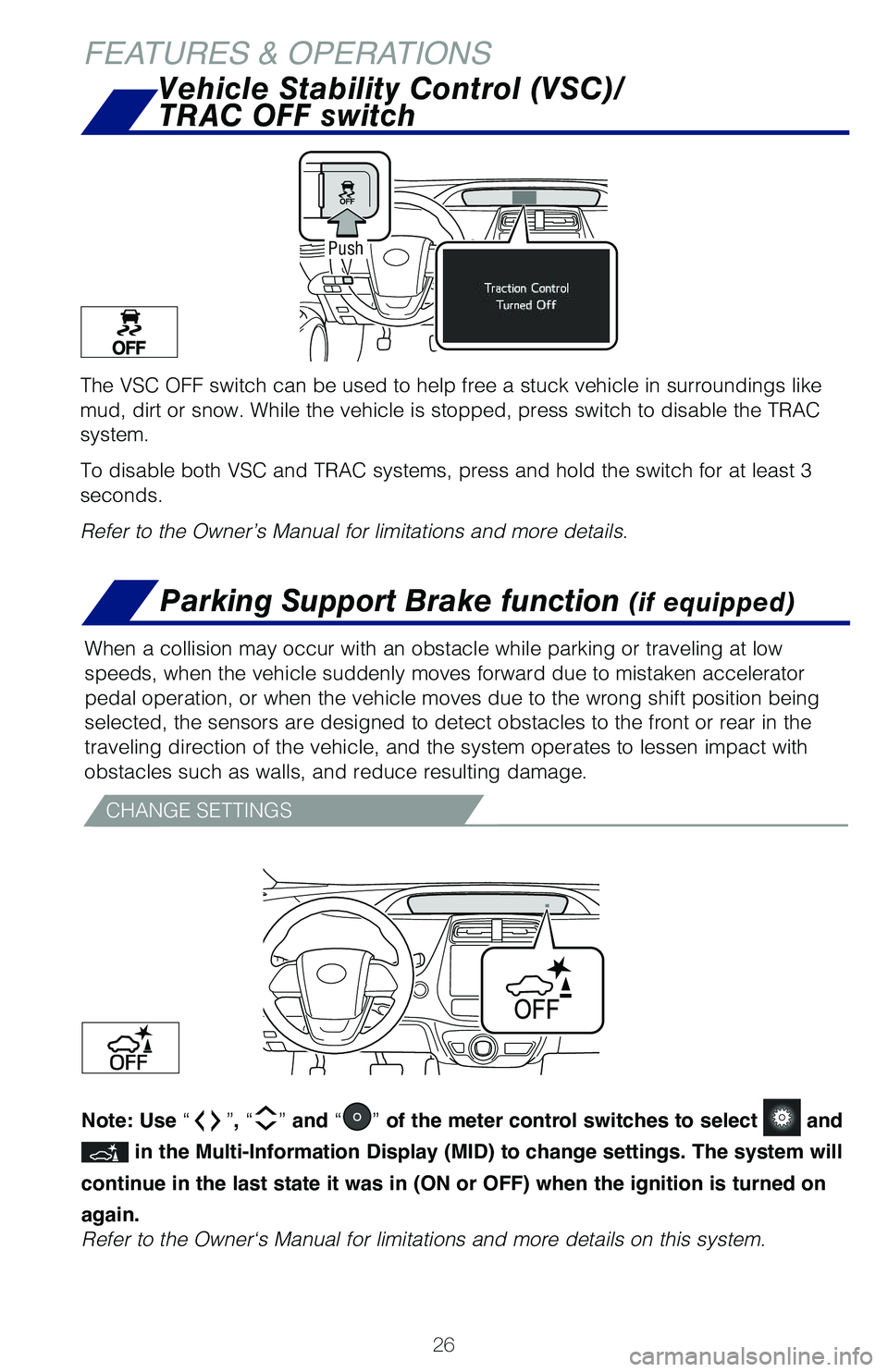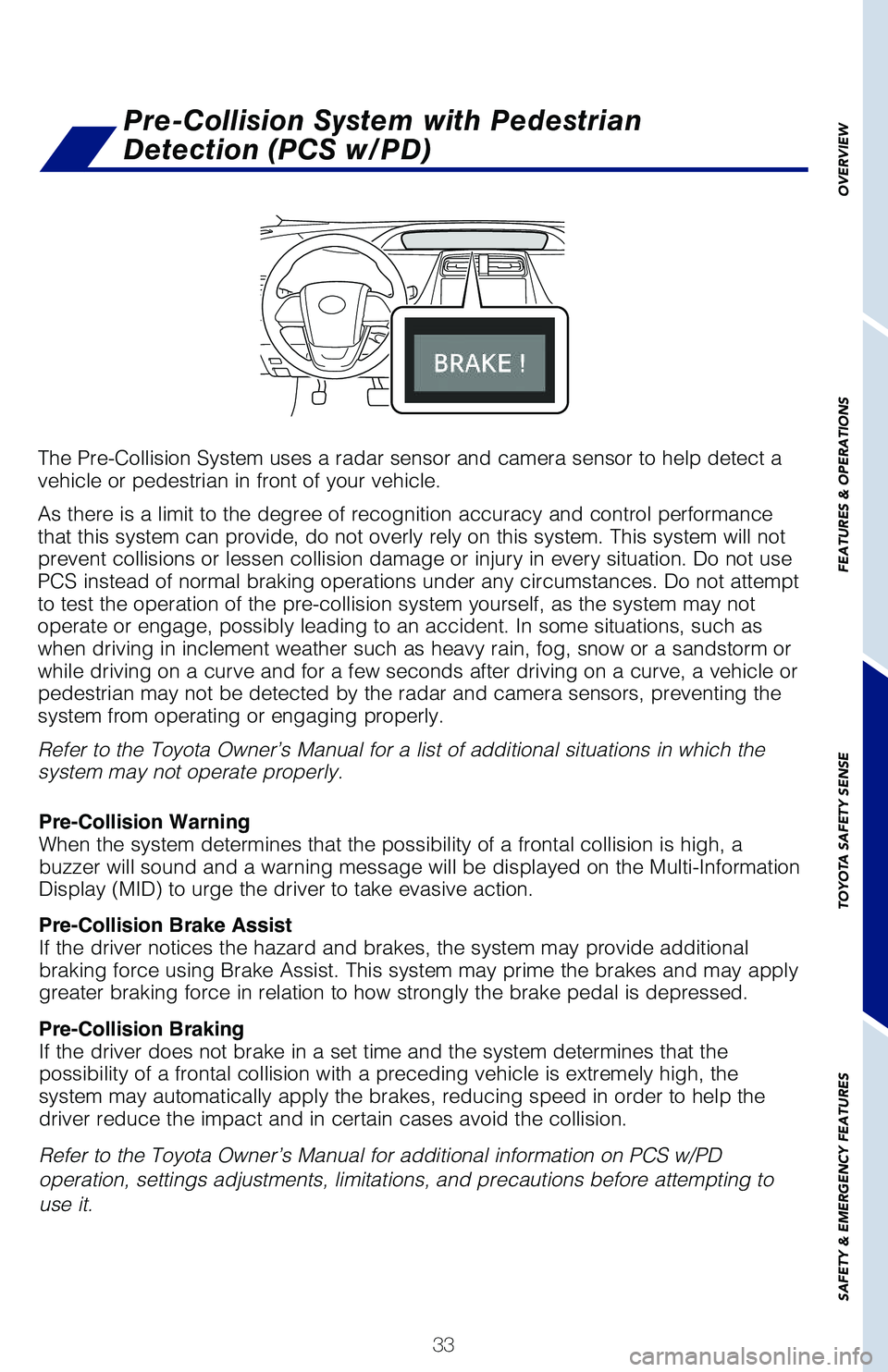2019 TOYOTA PRIUS brake sensor
[x] Cancel search: brake sensorPage 3 of 60

OVERVIEW
FEATURES & OPERATIONS
TOYOTA SAFETY SENSE
SAFETY & EMERGENCY FEATURES
1
INDEX
Engine maintenance 9
Fuel tank door release & cap 7
Hood release 8
Indicator symbols 4-5
Instrument cluster 4
Instrument panel 2-3
Instrument panel light control 8
Keyless entry1,2 6
Smart Key system1,2 7
1 Visit your Toyota dealer for information on customizing this feature.2 Programmable by customer. Refer to the Owner’s Manual for instructions and more information.3 HomeLink® is a registered trademark of Gentex Corporation.
OVERVIEWFEATURES & OPERATIONS (continued)
FEATURES & OPERATIONS
SAFETY & EMERGENCY FEATURES
TOYOTA SAFETY SENSE™ P (TSS-P)Air conditioning/heating 22-23
Audio 18-19
Auto lock/unlock1,2 10
Blind Spot Monitor with Rear
Cross Traffic Alert (BSM w/RCTA) 29
Clock 25
Color Dual Multi-Information
Display (MID)2 24
Door locks 14
Color Head-up Display (HUD) 25
Driving mode select switch 11
EV drive mode switch 11
Garage door opener (HomeLink®)3 28
Hybrid Synergy Drive System 10
Hybrid transmission 11
Intelligent Parking Assist (IPA) 30-31
Intuitive Parking Assist 27
Lights1 & turn signals 16
Moonroof 14
Parking Support Brake function 26
Parking brake 12
Power outlets-12V DC 20
Qi wireless charger 20
Rear view monitor system 28
Seat adjustments-Front 13
Seat heaters 22
Seats-Folding down rear seat 13
Seats-Head restraints 13
Floor mat installation 49
Rear door child safety locks 44
Safety Connect 44
Seat belts 43
Seat belts-Shoulder belt anchor 43
Spare tire & tools 46
Star Safety System™ 48-49
Tire Pressure Monitoring
(warning) System (TPMS) 45
Tire repair kit & tools 47
Automatic High Beams (AHB) 42
Full-Speed Range Dynamic Radar
Cruise Control (DRCC) 39-41
Lane Departure Alert with
Steering Assist (LDA w/SA) 35-38
Pre-Collision System with Pedestrian
Detection (PCS w/PD) 33-35
Quick overview-
Toyota Safety Sense™ P (TSS-P) 32
Sensors 32
Steering lock release 12
Steering wheel-Heater 21
Steering wheel switches &
Telephone controls (Bluetooth®) 17
Tilt & telescopic steering wheel 12
USB charge-ports 21
USB media/AUX Port 21
Vehicle Stability Control
(VSC)/TRAC OFF switch 26
Windows-Power 14
Windshield wipers & washers 15
BLUETOOTH® DEVICE PAIRING SECTION 50-56
116674_MY19_Prius_QRG_V3_ML_1126_TEXT_R1.indd 111/26/18 10:52 PM
Page 28 of 60

26
FEATURES & OPERATIONS
The VSC OFF switch can be used to help free a stuck vehicle in surroundings like
mud, dirt or snow. While the vehicle is stopped, press switch to disable the TRAC
system.
To disable both VSC and TRAC systems, press and hold the switch for at least 3
seconds.
Refer to the Owner’s Manual for limitations and more details.
Push
Parking Support Brake function (if equipped)
Vehicle Stability Control (VSC)/
TRAC OFF switch
When a collision may occur with an obstacle while parking or traveling at low
speeds, when the vehicle suddenly moves forward due to mistaken accelerator
pedal operation, or when the vehicle moves due to the wrong shift position being
selected, the sensors are designed to detect obstacles to the front or rear in the
traveling direction of the vehicle, and the system operates to lessen impact with
obstacles such as walls, and reduce resulting damage.
CHANGE SETTINGS
Note: Use “”, “” and “” of the meter control switches to select and
in the Multi-Information Display (MID) to change settings. The system will
continue in the last state it was in (ON or OFF) when the ignition is turned on
again.
Refer to the Owner‘s Manual for limitations and more details on this system.
116674_MY19_Prius_QRG_V3_ML_1126_TEXT_R1.indd 2611/26/18 10:52 PM
Page 35 of 60

33
OVERVIEW
FEATURES & OPERATIONS
TOYOTA SAFETY SENSE
SAFETY & EMERGENCY FEATURES
The Pre-Collision System uses a radar sensor and camera sensor to help detect a vehicle or pedestrian in front of your vehicle.
As there is a limit to the degree of recognition accuracy and control performance that this system can provide, do not overly rely on this system. This system will not prevent collisions or lessen collision damage or injury in every situation. Do not use PCS instead of normal braking operations under any circumstances. Do not attempt to test the operation of the pre-collision system yourself, as the system may not operate or engage, possibly leading to an accident. In some situations, such as when driving in inclement weather such as heavy rain, fog, snow or a sandstorm or while driving on a curve and for a few seconds after driving on a curve, a vehicle or pedestrian may not be detected by the radar and camera sensors, preventing the system from operating or engaging properly.
Refer to the Toyota Owner’s Manual for a list of additional situations in which the system may not operate properly.
Refer to the Toyota Owner’s Manual for additional information on PCS w/PD
operation, settings adjustments, limitations, and precautions before attempting to
use it.
Pre-Collision WarningWhen the system determines that the possibility of a frontal collision is high, a buzzer will sound and a warning message will be displayed on the Multi-Information Display (MID) to urge the driver to take evasive action.
Pre-Collision Brake AssistIf the driver notices the hazard and brakes, the system may provide additional braking force using Brake Assist. This system may prime the brakes and may apply greater braking force in relation to how strongly the brake pedal is depressed.
Pre-Collision BrakingIf the driver does not brake in a set time and the system determines that the possibility of a frontal collision with a preceding vehicle is extremely high, the system may automatically apply the brakes, reducing speed in order to help the driver reduce the impact and in certain cases avoid the collision.
Pre-Collision System with Pedestrian
Detection (PCS w/PD)
116674_MY19_Prius_QRG_V3_ML_1126_TEXT_R1.indd 3311/26/18 10:52 PM
Page 36 of 60

34
CHANGING PCS ALERT TIMING
TOYOTA SAFETY SENSE™
Far
Middle(default)
Near
(1) Press “” switches and select from the Multi-Information Display (MID).
(2) Press “” switches and select from the MID and then press “”. The
setting screen is displayed.
(3) Press “” each time to change the setting. Each time it is pressed, the
response to the PCS alert timing changes as shown above. You can press “” to
go back to the menu.
Note: PCS is enabled each time the engine switch is turned to Ignition On. The system can be disabled/enabled and the alert timing of the system can be changed. (Alert timing only, brake operation remains the same).
Monocular camera sensor
Millimeterwave radar
As part of the Pre-Collision System, this function is also designed to first provide an alert and then automatic braking if needed.
Under certain conditions, the PCS system included with the TSS-P package may also help to detect a pedestrian in front of your vehicle using the in-vehicle camera and front-grill mounted millimeter wave radar. The in-vehicle camera of PCS detects a potential pedestrian based on size, profile, and motion of the detected pedestrian. However, a pedestrian may not be detected depending on the conditions, including the surrounding brightness and the motion, posture, size, and angle of the potential detected pedestrian, preventing the system from operating or engaging.
PCS PEDESTRIAN DETECTION
Refer to the Toyota Owner’s Manual for additional limitations and information.
116674_MY19_Prius_QRG_V3_ML_1126_TEXT_R1.indd 3411/26/18 10:52 PM
Page 42 of 60

40
ADJUSTING DISTANCE
To change the vehicle-to-vehicle distance
Push the “” button to cycle
through the settings, which will
change progressively.
This mode employs a radar sensor to detect the presence of a preceding vehicle
up to approximately 328 ft (100 m) ahead, determines the current vehicle-to-vehicle
following distance and operates to maintain a preset following distance from the
vehicle ahead. These distances vary based on vehicle speed.
Preceding vehicle mark
LONG(default setting)MIDDLESHORT
(1) (2) (3)
(1) Constant speed cruising when there are no vehicles ahead
The vehicle travels at the speed set by the driver. The desired vehicle-to-
vehicle distance can also be set by operating the vehicle-to-vehicle distance
control.
(2) Deceleration cruising and follow-up cruising when a preceding vehicle
driving slower than the set speed appears
When a vehicle is detected running ahead of you, the system automatically
decelerates your vehicle. When a greater reduction in vehicle speed is
necessary, the system applies the brakes (the brake lights will come on at this
time). The system will respond to changes in the speed of the vehicle ahead
in order to maintain the vehicle-to-vehicle distance set by the driver. A warning
tone warns you when the system cannot decelerate sufficiently to prevent your
vehicle from closing in on the vehicle ahead.
Note: Vehicle-to-vehicle distance will close in when traveling on long downhill
slopes.
TOYOTA SAFETY SENSE™
116674_MY19_Prius_QRG_V3_ML_1126_TEXT_R1.indd 4011/26/18 10:52 PM
Page 50 of 60

48
SAFETY & EMERGENCY FEATURES
SMART STOP TECHNOLOGY (SST)
Star Safety System™
Smart Stop Technology automatically reduces engine power when the accelerator
and brake pedals are pressed simultaneously under certain conditions.
SST engages when the accelerator is depressed first and the brakes are applied
firmly for longer than one-half second at speeds greater than five miles per hour.
SST doesn’t engage if the brake pedal is depressed before the accelerator pedal,
allowing vehicles to start on a steep hill and safely accelerate without rolling
backward.
Refer to the Brake Override System section in the Owner’s Manual for more
information on Smart Stop Technology.
ENHANCED VEHICLE STABILITY CONTROL (VSC)
Enhanced Vehicle Stability Control provides cooperative control of the ABS, TRAC,
VSC and EPS.
Enhanced VSC helps to maintain directional stability when loss of traction occurs
during a turn.
ANTI-LOCK BRAKE SYSTEM (ABS)
Toyota’s ABS sensors detect which wheels are locking up and limits wheel lockup
by “pulsing” each wheel’s brakes independently. Pulsing releases brake pressure
repeatedly for fractions of a second. This helps the tires attain the traction that
current road conditions will allow, helping you to stay in directional control.
BRAKE ASSIST (BA)
Brake Assist is designed to detect sudden or “panic” braking, and then add braking
pressure to help decrease the vehicle’s stopping distance. When there’s only a split
second to react, Brake Assist can add additional brake pressure more quickly than
just the driver alone can.
ELECTRONIC BRAKE FORCE DISTRIBUTION (EBD)
Toyota’s ABS technology has Electronic Brake-force Distribution (EBD) to help
maintain control and balance when braking. EBD responds to sudden stops by
redistributing brake force to enhance the braking effectiveness of all four wheels.
Your vehicle comes standard with the Star Safety SystemTM, which combines Anti-
lock Braking System (ABS), Brake Assist (BA), Electronic Brake-force Distribution
(EBD), Smart Stop Technology (SST), Traction Control (TRAC) and Vehicle Stability
Control (VSC).
Refer to the Owner’s Manual for more details and important information on limitations
to these systems.
116674_MY19_Prius_QRG_V3_ML_1126_TEXT_R1.indd 4811/26/18 10:52 PM
Page 51 of 60

49
OVERVIEW
FEATURES & OPERATIONS
TOYOTA SAFETY SENSE
SAFETY & EMERGENCY FEATURES
Floor mat installation
Always align the marks
There are two types of Toyota floor mats: carpeted and all-weather. Each vehicle
has model-specific floor mats. Installation is easy.
To keep your floor mat properly positioned, follow these steps:
• Only use Toyota floor mats designed for your specific model.
• Use only one floor mat at a time, using the retaining hooks to keep the mat in
place.
• Install floor mats right side up.
TRACTION CONTROL (TRAC)
VSC helps prevent loss of traction during cornering by reducing Hybrid System
output, and Traction Control helps maintain traction on loose gravel and wet, icy, or
uneven surfaces by applying brake force to the spinning wheel(s).
Toyota’s TRAC sensors are activated when one of the drive wheels starts to slip.
TRAC limits Hybrid System output and applies the brakes to the spinning wheel.
This transfers power to the wheels that still have traction to help keep you on track.
116674_MY19_Prius_QRG_V3_ML_1126_TEXT_R1.indd 4911/26/18 10:52 PM